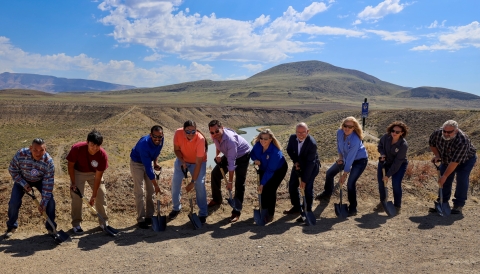The Numana Dam Fish Passage Project will remove an in-stream migration barrier and allow two federally listed and culturally important fish species to have access to an additional 65 miles of their historic habitat in the Truckee River and augment decades of recovery efforts made possible by a longstanding partnership between the Pyramid Lake Paiute Tribe, the U.S. Fish and Wildlife Service, Bureau of Indian Affairs, Bureau of Reclamation and others. The momentum of this partnership paved the way for securing nearly $8.3 million Bipartisan Infrastructure Law Bipartisan Infrastructure Law
The Bipartisan Infrastructure Law (BIL) is a once-in-a-generation investment in the nation’s infrastructure and economic competitiveness. We were directly appropriated $455 million over five years in BIL funds for programs related to the President’s America the Beautiful initiative.
Learn more about Bipartisan Infrastructure Law funding in 2022 to install this fish passage fish passage
Fish passage is the ability of fish or other aquatic species to move freely throughout their life to find food, reproduce, and complete their natural migration cycles. Millions of barriers to fish passage across the country are fragmenting habitat and leading to species declines. The U.S. Fish and Wildlife Service's National Fish Passage Program is working to reconnect watersheds to benefit both wildlife and people.
Learn more about fish passage infrastructure at Numana Dam.
Numana Dam is an irrigation diversion structure structure
Something temporarily or permanently constructed, built, or placed; and constructed of natural or manufactured parts including, but not limited to, a building, shed, cabin, porch, bridge, walkway, stair steps, sign, landing, platform, dock, rack, fence, telecommunication device, antennae, fish cleaning table, satellite dish/mount, or well head.
Learn more about structure within the boundary of the Pyramid Lake Paiute Tribe’s Reservation on the Truckee River and provides irrigation water to Pyramid Lake Paiute Tribal farmers and ranchers. This structure has been in place since 1917 and in its present form has been a significant passage barrier for the endangered Cui-ui sucker (Chasmistes cujus), and most recently for the reestablished migration and natural reproduction of the threatened Lahontan cutthroat trout (Oncorhynchus clarkii henshawi). Both species are culturally very important to the Pyramid Lake Paiute Tribe.
This project contributes substantially towards recovery of these species. Recovering the iconic population of Lahontan cutthroat trout at Pyramid Lake also provides a unique recreational angling experience that is recognized locally, nationally and internationally as a world class fishery. The restoration of this population provides economic benefit to the Pyramid Lake Paiute Tribe and local communities.
Quick Facts:
Project Status | In Construction |
Location | NV, Washoe |
NFPP Project Funding | $8,292,215 |
Restoration Techniques | Dam Modification |
Accomplishments | 65 Stream Miles Reopened |
Project Partner Lead | Pyramid Lake Paiute Tribe |
Primary Species Benefited | Cui-ui |
The National Fish Passage Program combines technical expertise with a track record of success.
Implemented primarily through the Service's Fish and Wildlife Conservation Offices, the National Fish Passage Program provides financial and technical assistance to partners across the country. Since 1999, the program has worked with over 2,000 local communities, Tribes, and private landowners to remove or bypass over 3,400 barriers to fish passage and reopen access to over 61,000 miles of upstream habitat for fish and other animals. Staff have expertise in fish migration and biology as well as financial, engineering, and planning assistance to communities, Tribes, and landowners to help them remove barriers and restore rivers for the benefit both fish and people.
Fish passage project proposals can be initiated by any individual, organization, government, or agency. However, proposals must be submitted and completed in cooperation with a Fish and Wildlife Conservation Office. (Please note that fish passage projects being used for federal or state compensatory mitigation or required by existing federal or state regulatory programs are not eligible for funding through the National Fish Passage Program.)
CONTACT A FISH PASSAGE COORDINATOR IN YOUR AREA TO GET STARTED.




